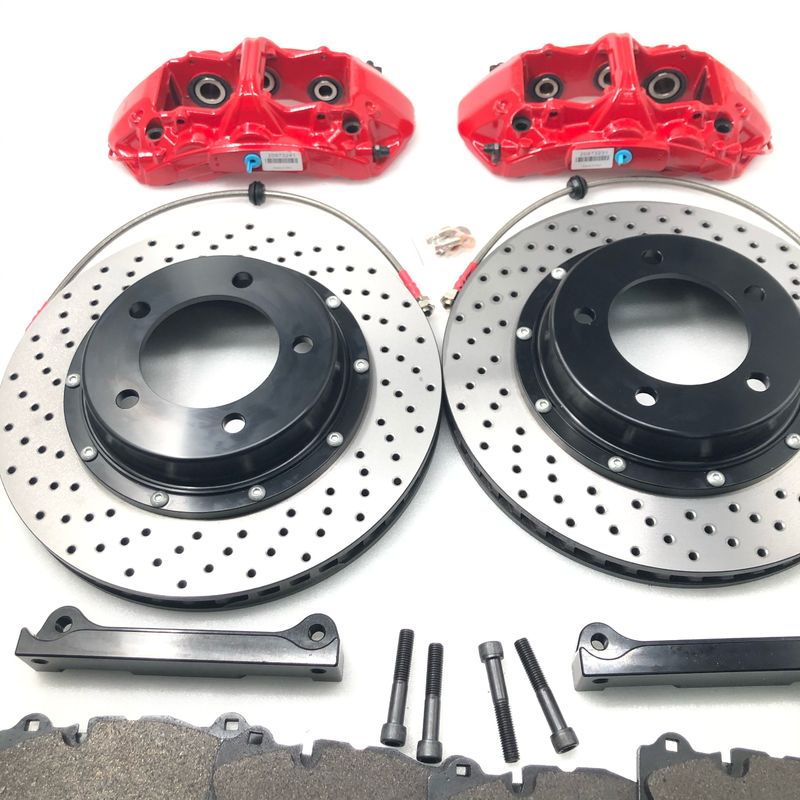Product Description
Jekit Red Aluminun Brake Caliper GT6 362*32mm Drilled Disc System
| Item Name |
GT6 Six Pots Brake Caliper Kit |
| Disc Rotor Size |
362*32mm |
| Piston Size |
30/34/38mm |
| Piston Area |
52.14mm |
| Hydraulic Thread |
M10x1-6H |
| Mounting Offset |
55mm |
| Mounting Hole Center |
200mm |
| Mounting Hole Diameter |
12.2 |
Attentions:
One set of brake kit includes:
2pcs calipers; brake calipers
2pcs discs; brembo brake caliper
2pcs center hats; brembo brake caliper
2pcs brackets; caliper covers
2pcs steel pipes; caliper covers
4pcs brake pads. caliper covers
(One set of kit is only for two car wheels. NOT for 4 wheels, so one car needs 2 sets
of brake kits.Front and Rear.)
Pls provides your car model,years, wheel rims size and displacement!
Why Do you Need New Brake Calipers?
Most brake calipers do not need to be rebuilt or replaced the first time the brakes are relined. But after 75,000 miles, or seven to 10 years of service, the calipers may be reaching the end of the road. As the rubber seals age and harden, the risk of sticking and leaking goes up.
Few shops rebuild their own calipers these days because it takes too long and increases the risk of a comeback if the caliper sticks or leaks. It’s easier, faster and safer to simply replace the old calipers with new or remanufactured calipers. Loaded calipers are even better because they give you everything you need in one box, and there’s much less chance of mismatched parts.
Caliper replacement is required if a caliper is leaking brake fluid, if a piston is sticking, or the caliper is worn or damaged. Leaks are very dangerous and should never be ignored because loss of fluid can cause brake failure.
Leaks eventually occur as the caliper ages and the piston seals become hard and lose their elasticity. Corrosion inside the piston bores or on the pistons themselves can also accelerate seal wear. When you push the pistons back into the caliper to install new pads, it forces the piston seal to scrape across areas of the bore that may be rough with corrosion. If the caliper was not leaking before, it may soon start.
The condition of the caliper slides, pins and bushings on floating calipers should also be carefully inspected for wear, rust, cracks or other damage. If you’re replacing a caliper, use new slides, bushings and mounting hardware, and be sure to grease these parts with a high-temperature, moisture-resistant brake lubricant.
If the slides or bushings on a floating caliper are rusty, worn or damaged, the caliper may not move freely causing the pads to wear unevenly. A “sticky” or “frozen” caliper may also cause the brakes to drag if the caliper does not slide so the outer pad can kick away from the rotor. This may cause increased wear on the outer pad as well as a steering pull to one side because of the constant drag. Fixed calipers don’t suffer from this type of problem because the position of the caliper is fixed and the caliper does not move. But both fixed and floating calipers alike can sometimes “freeze up” or lock if a piston becomes jammed or stuck in its bore due to corrosion or swelling.
When a piston sticks, one of two things can happen: the brake may not apply or it may not release. The uneven braking that results may produce a hard pull toward the “good” side when the brakes are applied, and/or a steering pull toward the “bad” side when the brakes are released.
If you find uneven pad wear between the inner and outer disc brake pads, it’s a sure indication the caliper (or caliper piston) is sticking.
Calipers should usually be replaced in pairs, especially on high-mileage vehicles. But if only one caliper needs to be replaced because of a leak or problem, the replacement caliper should have the same type of piston (steel or phenolic) as the one on the opposite side, as well as the same type of friction material (nonasbestos organic or semi-metallic). Mismatches side-to-side may cause uneven braking. Other items that may be needed when replacing calipers include new brake hoses (replace if leaking, cracked, brittle or worn), and certainly brake fluid. Always flush the brakes to get rid of the old fluid, and bleed all of the lines to get rid of any trapped air that could cause a soft pedal.
We can offer you brake kit fit for you
1. Lightweight:The clamp body is made of high-strength aluminum alloy with lightweight design.
2. Noise reduction and Anti-shake:No abnormal noise,Anti-shake,braking is more sensitive and safer.
3. Sudden brake steady stop:The brake pad is made of ceramic material, which can effectively shorten the braking distance.
4. Anti-friction and Longevity:Good corrosion resistance, dense materials without defects
5. High temperature resistant:Obvious heat dissipation, effectively restrain the thermal attenuation caused by the brake
6. Oil temperature control:The modified multi-piston caliper is stronger than the original cast iron caliper, which effectively controls the brake oil temperature



 Your message must be between 20-3,000 characters!
Your message must be between 20-3,000 characters! Please check your E-mail!
Please check your E-mail!  Your message must be between 20-3,000 characters!
Your message must be between 20-3,000 characters! Please check your E-mail!
Please check your E-mail!





